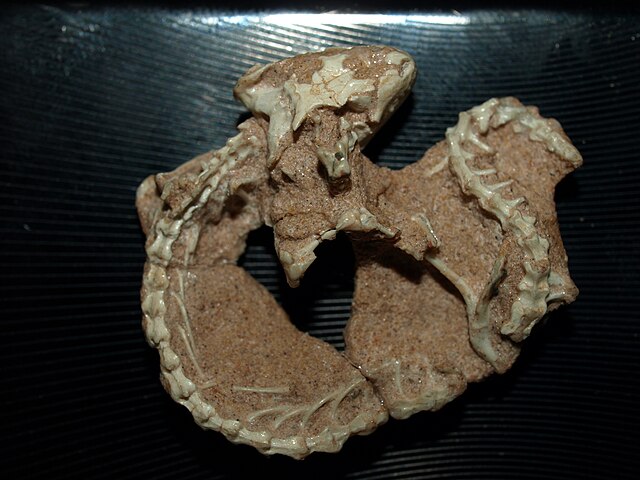Squamata is the largest order of reptiles, comprising lizards and snakes. With over 11,500 species, it is also the second-largest order of extant (living) vertebrates, after the perciform fish. Squamates are distinguished by their skins, which bear horny scales or shields, and must periodically engage in molting. They also possess movable quadrate bones, making possible movement of the upper jaw relative to the neurocranium. This is particularly visible in snakes, which are able to open their mouths very wide to accommodate comparatively large prey. Squamates are the most variably sized living reptiles, ranging from the 16 mm (0.63 in) dwarf gecko to the 6.5 m (21 ft) reticulated python. The now-extinct mosasaurs reached lengths over 14 m (46 ft).
Squamata
The holotype of Slavoia darevskii, a fossil squamate
Trachylepis maculilabris skinks mating
The Japanese striped snake has been studied in sexual selection.
Reptiles, as commonly defined, are a group of tetrapods with an ectothermic ('cold-blooded') metabolism and amniotic development. Living reptiles comprise four orders: Testudines (turtles), Crocodilia (crocodilians), Squamata, and Rhynchocephalia. As of May 2023, about 12,000 living species of reptiles are listed in the Reptile Database. The study of the traditional reptile orders, customarily in combination with the study of modern amphibians, is called herpetology.
Reptile
Reptiles, from Nouveau Larousse Illustré, 1897–1904, notice the inclusion of amphibians (below the crocodiles)
"Antediluvian monster", a Mosasaurus discovered in a Maastricht limestone quarry, 1770 (contemporary engraving)
The first reptiles had an anapsid type of skull roof, as seen in the Permian genus Captorhinus








